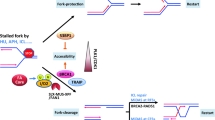Summary
Fanconi anaemia (FA) cells are extremely sensitive to crosslinking agents, e. g. mitomycin C, but only moderately sensitive to trimethylpsoralen plus UVA. Evidence has been reported suggesting that there is a deficient DNA crosslink repair mechanism in FA cells, but others failed to confirm this conclusion using other methods and other crosslinking agents. We reinvestigated the mitomycin C and 8-methoxypsoralen crosslink repair in FA cells with a high sensitivity to mitomycin C. Although an essentially similar methodology was used to that previously described, no difference between the control and FA cell strains was observed, neither for mitomycin C- nor for 8-methoxypsoralen-induced crosslinks.
Similar content being viewed by others
References
Auerbach, AD, Wolman SR (1976) Susceptibility of Fanconi's anaemia fibroblasts to chromosome damage by carcinogens. Nature 261:494–496
Bredberg A, Lambert B, Söderhäll S (1982) Induction and repair of psoralen crosslinks in DNA of normal human and xeroderma pigmentosum fibroblasts. Mutat Res 931:221–234
Fanconi G (1967) Familial constitutional panmyelopathy: Fanconi's anemia (FA). I. Clinical aspects Semin Hematol 4:233–240
Fornace AJ Jr, Little JB, Weichselbaum RR (1979) DNA repair in a Fanconi's anemia fibroblast cell strain. Biochim Biophys Acta 561:99–109
Fujiwara Y, Tatsumi M, Sasaki MS (1977) Crosslink repair in human cells and its possible defect in Fanconi's anemia cells. J Mol Biol 113:635–649
Fujiwara Y (1982) Defective repair of mitomycin c crosslinks in Fanconi's anemia and loss in confluent normal human and xeroderma pigmentosum cells. Biochim Biophys Acta 699:217–225
Glanz A, Fraser F (1982) Spectrum of anomalies in Fanconi anemia. J Med Genet 19:412–416
Iyer VN, Szybalski W (1964) Mitomycins and porfyromycin: chemical mechanism of activation and crosslinking of DNA. Science 145:55–58
Kano Y, Fujiwara Y (1982) Dyskeratosis congenita: survival, sister chromatid exchange and repair following treatments with crosslinking agents Mutat Res 103:327–332
Kaye J, Smith C, Hanawalt PC (1980) DNA repair in human cells containing photoadducts of 8-methoxypsoralen or angelicin. Cancer Res 40:696–702
Kwee ML, Poll EHA, van de Kamp JJP, de Koning H, Eriksson AW, Joenje H (1983) Unusual response to bifunctional alkylating agents in a case of Fanconi anaemia. Hum Genet 64:384–387
Lipsett MN, Weissbach A (1965) The site of alkylation of nucleic acids by mitomycin c. Biochemistry 4:206–211
Poll EHA, Arwert F, Joenje H, Eriksson AW (1982) Cytogenetic toxicity of antitumor platinum compounds in Fanconi's anemia. Hum Genet 61:228–230
Sasaki MS, Tonomura M (1973) A high susceptibility of Fanconi's anemia to chromosome breakage by DNA crosslinking agents. Cancer Res 33:1829–1836
Sasaki MS (1975) Is Fanconi's anemia defective in a process essential to the repair of DNA crosslinks? Nature 257:501–503
Sasaki MS (1978) Fanconi's anemia condition possibly associated with a defective DNA repair. In: Hanawalt PC, Friedberg EC, Fox CF (eds) DNA repair mechanisms. ICN-UCLA Symposia on molecular and cellular biology, vol IX, p 675
Schroeder TM, Anschütz F, Knopp A (1964) Spontane Chromosomenaberrationen bei familiärer Panmyelopathie. Humangenetik 1:194–196
Schroeder TM, Kurth R (1971) Spontaneous chromosomal breakage and high incidence of leukemia in inherited disease. Blood 37:96–112
Schroeder TM (1982) Genetically determined chromosome instability syndromes. Cytogenet Cell Genet 33:119–132
Song PS, Tapley KJ Jr (1979) Photochemistry and photobiology of psoralens. Photochemistry and Photobiology 29:1177–1197
Sognier MA, Hittelman WN (1983) Loss of repairability of DNA interstrand crosslinks in Fanconi's anemia cells with culture age. Mutat Res 108:383–393
Author information
Authors and Affiliations
Rights and permissions
About this article
Cite this article
Poll, E.H.A., Arwert, F., Kortbeek, H.T. et al. Fanconi anaemia cells are not uniformly deficient in unhooking of DNA interstrand crosslinks, induced by mitomycin C or 8-methoxypsoralen plus UVA. Hum Genet 68, 228–234 (1984). https://doi.org/10.1007/BF00418393
Received:
Revised:
Issue Date:
DOI: https://doi.org/10.1007/BF00418393




